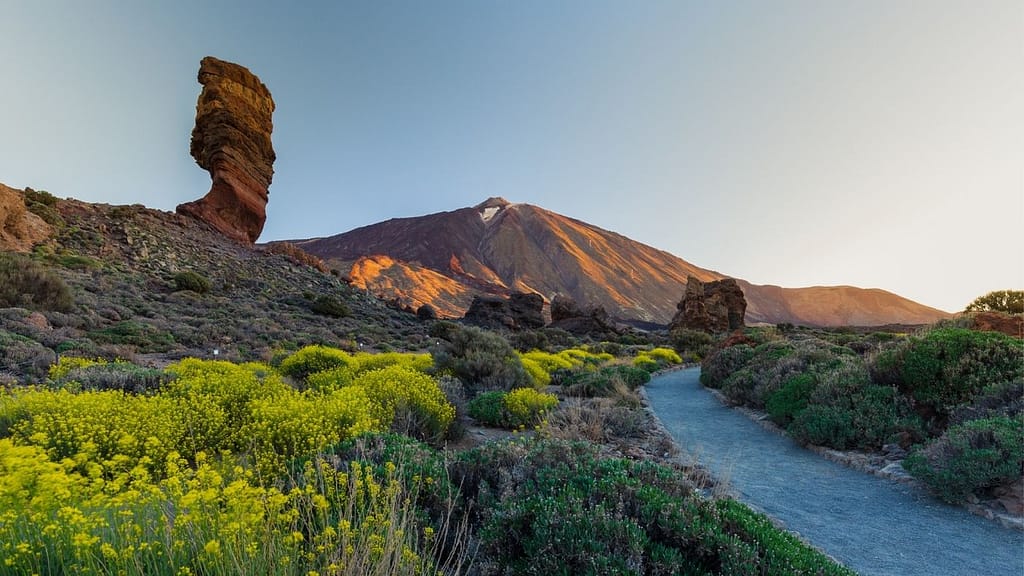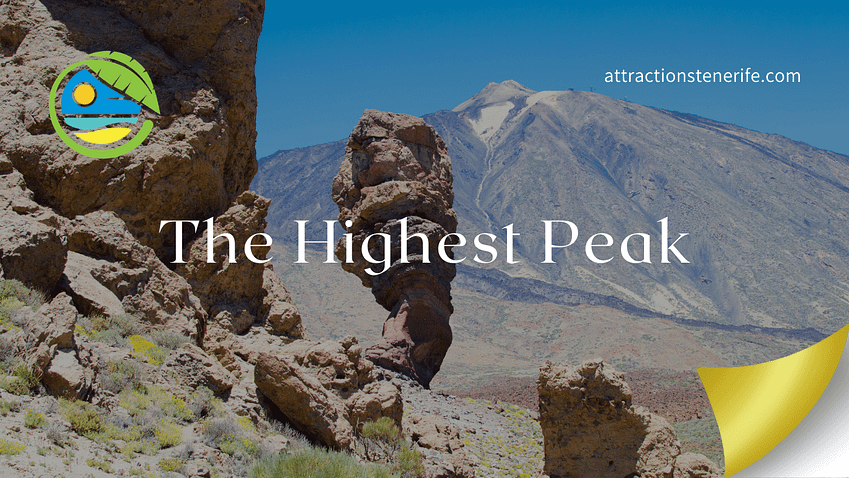Estimated reading time: 11 minutes
Mount Teide Volcano: An In-Depth Exploration and Analysis
Sightsee the highest peak in Spain – Mount Teide in Tenerife – featuring the world’s voluminous volcano and otherworldly landscapes. Unforgettable experiences await.

Teide National ParkMount Teide is a true marvel of nature, as it is the highest peak not only in the Canary Islands but also in the whole of Spain.
Situated in Teide National Park, this extraordinary volcano holds the title of being the third-highest volcanic structure and the most voluminous in the world after Mauna Loa and Mauna Kea in Hawaii.
Its formation began around 170,000 years ago, following the collapse of a previously even larger volcanic edifice. Today, Mount Teide attracts countless visitors to witness its stunning landscapes and explore the remarkable geology found within its surroundings.
As I first set foot in Teide National Park, I was captivated by the breathtaking and otherworldly landscapes that greeted me. The beautifully twisted rock formations and vibrant colours of the terrain made me feel as if I had stepped onto another planet.
Declared a UNESCO World Heritage Site in 2007, the park and its majestic volcano play a crucial role in the overall identity of the Canary Islands, as well as in Spain’s natural heritage.
Visitors from all around the globe flock to witness the awe-inspiring beauty this park offers, whether they choose to hike, take a cable car ride, or simply traverse the park by car, the awe and admiration for Mount Teide remain constant.
Experiencing Mount Teide firsthand has convinced me that it should undoubtedly be on every traveller’s bucket list.
The volcano’s unique geological features, its stunning landscapes, and the fact that it holds such impressive records make it an unforgettable destination for anyone seeking to explore the wonders that nature has to offer.
Attractions Tenerife
Formation and Geological Features of Mount Teide, Tenerife
Stratovolcano Characteristics
As a geology enthusiast, I find Mount Teide fascinating. Its formation began about 170,000 years ago, and it has since become the third-highest volcanic structure in the world, following Mauna Loa and Mauna Kea in Hawaii.
Being a stratovolcano, it exhibits features such as steep slopes, built from alternating layers of lava flows and ash deposits. This type of formation is common in stratovolcanoes due to their highly explosive eruptions.
Las Cañadas Caldera

Another significant feature of Mount Teide is the Las Cañadas Caldera. This massive depression, situated at the base of the volcano, was formed as a result of numerous explosive eruptions.
The caldera’s steep walls, some of which reach heights of up to 600 meters, along with the erosion caused by the Atlantic’s oceanic forces, have shaped its unique landscape.
This geological structure truly is a sight to behold.
Pico Viejo and Montaña Blanca

While Mount Teide is the star of the show, Pico Viejo and Montaña Blanca also play important roles in completing the region’s geological story.
Pico Viejo, Teide‘s twin peak, is the second-highest summit in Tenerife. Its last known eruption occurred in 1798, and it has a vibrant history of volcanic activity.
On the other hand, Montaña Blanca is a slightly more gentle presence. Its lower and broader slopes are covered in lighter-coloured volcanic material, contrasting with the darker hues of the main summit.
This fascinating interplay between the region’s geological features creates a beautiful and dynamic landscape that I cannot help but admire.
Eruption History and Current Status

In my research, I found that Mount Teide, located in the Canary Islands, has experienced several eruptions throughout its history. The formation of this volcanic structure began around 170,000 years ago after the collapse of a larger volcanic edifice.
Since that time, it has grown to become the third-highest volcanic structure in the world, and the highest peak in Spain.
As an active volcano, Mount Teide‘s last recorded eruption occurred in 1909 from the El Chinyero vent. The eruptions span approximately 204 years, from 1704 to 1908.
Given this information, it’s clear that Mount Teide has been active for centuries, consistently shaping the landscape of the Canary Islands and leaving a fascinating geological record.
Throughout its eruptive history, Mount Teide has gone through various stages of development. The Teide – Pico Viejo volcanic complex is unique in its intraplate setting and has been well-studied, with a set of 54 new 14 C and K/Ar ages providing a better understanding of its recent eruptive history.
Currently, Mount Teide is not erupting and is closely monitored by volcanologists and geologists to ensure the safety of nearby inhabitants and visitors.
Although the volcano has been dormant for over a century, its status as an active volcano still poses potential risks in case of future eruptions.
Teide National Park and UNESCO World Heritage Site
Teide National Park, situated in the centre of Tenerife, is not only the largest and oldest park among the Canary Islands but also houses Mount Teide, Spain’s highest peak at 3,718 meters.
In 2007, UNESCO named this park, which encompasses 18,900 hectares, a World Heritage Site.
Flora and Fauna

As I explored the national park, I discovered rich biodiversity, with varied flora and fauna that have adapted to the volcanic environment. This unique landscape harbours many endemic species unique to the Canary Islands.
Vegetation that caught my attention included brooms, flixweeds, and Red Tajinaste, a striking red-flowered plant found only in Tenerife.
Recreation and Hiking Trails

I found there to be numerous recreational opportunities in the park, including a vast network of hiking trails. These trails enable visitors to explore both the harsh volcanic landscapes and more verdant microclimates.
Some popular trails in the park include the Montaña Blanca, Roques de Garcia, and Taganana-Hastián trails.
Tenerife’s Mount Teide Cable Car

During my visit, I found the Teide Cable Car to be the easiest way for me to reach the upper slopes of the volcano.
The cable car effortlessly climbs 1,199 meters from the base station to La Rambleta, covering the distance in just 8 minutes. From there, I could take in the stunning views of the park and Tenerife.
Altavista Refuge
After my cable car ride, I discovered that the Altavista Refuge sits at an altitude of 3,260 meters. This mountain refuge offers overnight accommodations for hikers who plan to summit Mount Teide.
With a reservation, guests can stay at the refuge and prepare for the challenging but rewarding final ascent to the peak of Teide.
Mount Teide Observatory and Astronomical Significance

When I visited Mount Teide, I took the opportunity to explore the Teide Observatory, which is an astronomical observatory located at 2,390 meters (7,840 ft) above sea level in Tenerife, Spain.
Since its inauguration in 1964, the observatory has been operated by the Instituto de Astrofísica de Canarias and is known for making several significant astronomical observations.
I had the chance to witness the sunset from the observatory, which was a breathtaking sight to behold. It is said that the sky above Teide is exceptionally clear, making it an ideal location for observing stars and other celestial bodies.
During my time at the observatory, I learned about the discovery of the first brown dwarf, known as Teide-1, which was made using the telescope at the Teide Observatory.
The observatory has been instrumental in the study of various astronomical phenomena.
For instance, Charles Piazzi Smyth conducted numerous astronomical observations at Teide Observatory such as examining the Moon and planets, identifying Saturn and its rings, observing double stars, and studying zodiacal light, the ultraviolet radiation of the Sun and the infrared radiation of the Moon.
Teide Observatory serves as an important location for international astronomers, and it is one of the reasons why Mount Teide has gained prominence in the field of astrophysics.
I feel privileged to have experienced the astronomical significance of this observatory and look forward to learning more about the discoveries made there.
Cultural and Historical Significance of Mount Teide

Guanches and Sacred Mountain
The indigenous people of Tenerife, known as the Guanches, held Mount Teide in high regard as a sacred mountain. They believed that the volcano was home to the devil and the site of a mythical figure named Guayota, who was associated with destruction and malice.
The Guanches performed rituals and ceremonies around the mountain, demonstrating their deep reverential respect for the force of nature.
Renaissance Exploration
During the Renaissance, Mount Teide gained widespread attention among European explorers and scientists. The Spanish, who conquered the Canary Islands, were particularly interested in its volcanic landscapes, such as Las Cañadas del Teide and the Roques de García.
These formations allowed them to study geology and understand the workings of volcanoes from a scientific perspective. The island of Tenerife, with Mount Teide as its centrepiece, became a popular destination for many European travellers and researchers during this period.
Permits and Accessible Routes
Mount Teide‘s accessibility has been regulated over time to ensure the preservation of its natural environment and the safety of visitors.
Nowadays, if you’re planning to summit Mount Teide, it’s essential to obtain a permit from the authorities.
The permit system helps manage the number of visitors to the area, thus mitigating environmental impacts and preserving this unique volcanic landscape for future generations.
There are several accessible routes for those looking to explore Mount Teide and its surroundings. The most popular route is the Teide Cable Car, which takes visitors to a high-altitude viewpoint near the summit.
Additionally, various hiking trails traverse the national park, offering breathtaking views of the mountain, its unique geological formations, and the diverse landscapes of Tenerife.
It’s important to remember that hiking on Mount Teide might be challenging due to its steep terrain and high altitude, but the trails cater to varying levels of experience, allowing visitors to appreciate the natural beauty and historical significance of this remarkable volcanic landscape.
Comparisons with Other Global Volcanoes

When I consider the characteristics of Mount Teide volcano, it’s interesting to compare it with other global volcanoes like those in Hawaii.
At its summit, Mount Teide stands 3,715 m (12,188 ft) above sea level, making it the highest point in Spain and the highest point above sea level in the Atlantic islands.
On the other hand, Mauna Kea and Mauna Loa, two famous Hawaiian volcanoes, have elevations of 4,207 m (13,802 ft) and 4,169 m (13,678 ft), respectively.
Teide‘s height gets even more impressive when measured from the ocean floor; with a height of 7,500 m (24,600 ft), it ranks as the third tallest volcanic structure on Earth.
Comparatively, Mauna Loa, the largest volcano on Earth, has a height of approximately 9,144 m (30,000 ft) from the ocean floor to the summit.
Teide is considered a stratovolcano, featuring a steep cone shape built up by multiple layers of hardened lava, volcanic ash, and other materials. Similarly, Mauna Loa and Mauna Kea are considered shield volcanoes, which possess broad, gentle slopes formed by the accumulation of fluid lava flows.
Regarding the surrounding landscape, Mount Teide lies within the Orotava Valley, an area known for breathtaking views and unique geological features.
Meanwhile, the Hawaiian volcanoes reside on the Big Island of Hawaii, contributing to the island’s diverse ecosystem and geological scenery.
Plan Your Vacation with these useful links
- Find a flight
Kiwi.com – Helping you to find the cheapest airline tickets.
- Find an accommodation
Welcome to Tenerife. Enter your check-in date and choose from 9628 properties with Booking.com!
- Order taxi transfers from airports and hotels
Kiwi Taxi. Immediate departure, the driver meets you, pay online or in cash.
- Book Your Activities
Top sights you can’t miss in Tenerife! GetYourGuide.
- Rent a Car: Search, Compare, Save
Join now the many satisfied customers of Rentalcars.com – the leading car rental comparison website around the world. Only 3 steps separate you from “four wheels”!
- Ekta – is a new-generation insurance company that combines competitive prices with a high level of service.
You will receive your insurance policy by email within 2-3 minutes. There is a multilingual technical support chat 24/7.

